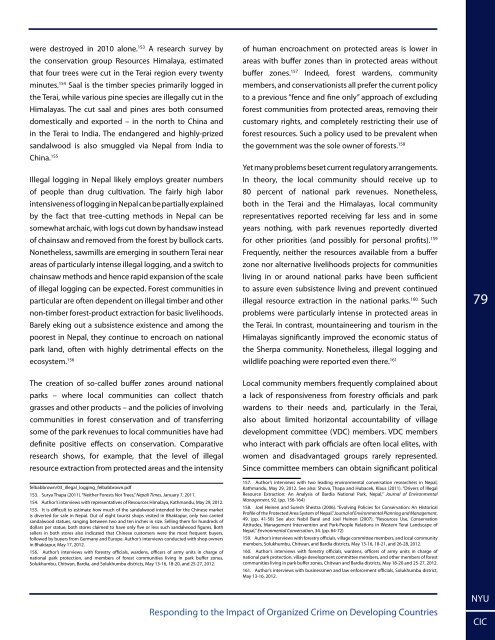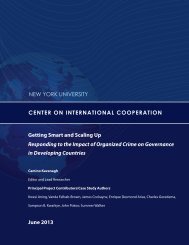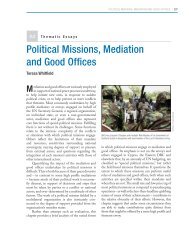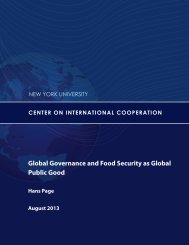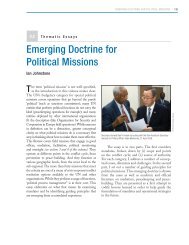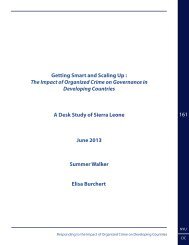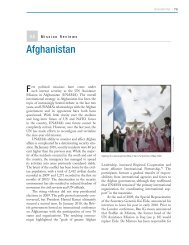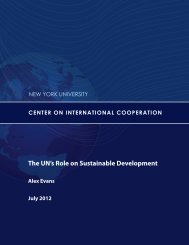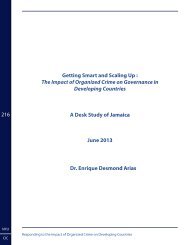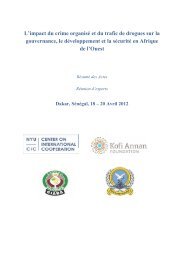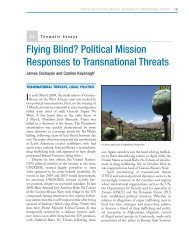here - Center on International Cooperation - New York University
here - Center on International Cooperation - New York University
here - Center on International Cooperation - New York University
Create successful ePaper yourself
Turn your PDF publications into a flip-book with our unique Google optimized e-Paper software.
were destroyed in 2010 al<strong>on</strong>e. 153 A research survey by<br />
the c<strong>on</strong>servati<strong>on</strong> group Resources Himalaya, estimated<br />
that four trees were cut in the Terai regi<strong>on</strong> every twenty<br />
minutes. 154 Saal is the timber species primarily logged in<br />
the Terai, while various pine species are illegally cut in the<br />
Himalayas. The cut saal and pines ares both c<strong>on</strong>sumed<br />
domestically and exported – in the north to China and<br />
in the Terai to India. The endangered and highly-prized<br />
sandalwood is also smuggled via Nepal from India to<br />
China. 155<br />
Illegal logging in Nepal likely employs greater numbers<br />
of people than drug cultivati<strong>on</strong>. The fairly high labor<br />
intensiveness of logging in Nepal can be partially explained<br />
by the fact that tree-cutting methods in Nepal can be<br />
somewhat archaic, with logs cut down by handsaw instead<br />
of chainsaw and removed from the forest by bullock carts.<br />
N<strong>on</strong>etheless, sawmills are emerging in southern Terai near<br />
areas of particularly intense illegal logging, and a switch to<br />
chainsaw methods and hence rapid expansi<strong>on</strong> of the scale<br />
of illegal logging can be expected. Forest communities in<br />
particular are often dependent <strong>on</strong> illegal timber and other<br />
n<strong>on</strong>-timber forest-product extracti<strong>on</strong> for basic livelihoods.<br />
Barely eking out a subsistence existence and am<strong>on</strong>g the<br />
poorest in Nepal, they c<strong>on</strong>tinue to encroach <strong>on</strong> nati<strong>on</strong>al<br />
park land, often with highly detrimental effects <strong>on</strong> the<br />
ecosystem. 156<br />
of human encroachment <strong>on</strong> protected areas is lower in<br />
areas with buffer z<strong>on</strong>es than in protected areas without<br />
buffer z<strong>on</strong>es. 157 Indeed, forest wardens, community<br />
members, and c<strong>on</strong>servati<strong>on</strong>ists all prefer the current policy<br />
to a previous “fence and fine <strong>on</strong>ly” approach of excluding<br />
forest communities from protected areas, removing their<br />
customary rights, and completely restricting their use of<br />
forest resources. Such a policy used to be prevalent when<br />
the government was the sole owner of forests. 158<br />
Yet many problems beset current regulatory arrangements.<br />
In theory, the local community should receive up to<br />
80 percent of nati<strong>on</strong>al park revenues. N<strong>on</strong>etheless,<br />
both in the Terai and the Himalayas, local community<br />
representatives reported receiving far less and in some<br />
years nothing, with park revenues reportedly diverted<br />
for other priorities (and possibly for pers<strong>on</strong>al profits). 159<br />
Frequently, neither the resources available from a buffer<br />
z<strong>on</strong>e nor alternative livelihoods projects for communities<br />
living in or around nati<strong>on</strong>al parks have been sufficient<br />
to assure even subsistence living and prevent c<strong>on</strong>tinued<br />
illegal resource extracti<strong>on</strong> in the nati<strong>on</strong>al parks. 160 Such<br />
problems were particularly intense in protected areas in<br />
the Terai. In c<strong>on</strong>trast, mountaineering and tourism in the<br />
Himalayas significantly improved the ec<strong>on</strong>omic status of<br />
the Sherpa community. N<strong>on</strong>etheless, illegal logging and<br />
wildlife poaching were reported even t<str<strong>on</strong>g>here</str<strong>on</strong>g>. 161<br />
79<br />
The creati<strong>on</strong> of so-called buffer z<strong>on</strong>es around nati<strong>on</strong>al<br />
parks – w<str<strong>on</strong>g>here</str<strong>on</strong>g> local communities can collect thatch<br />
grasses and other products – and the policies of involving<br />
communities in forest c<strong>on</strong>servati<strong>on</strong> and of transferring<br />
some of the park revenues to local communities have had<br />
definite positive effects <strong>on</strong> c<strong>on</strong>servati<strong>on</strong>. Comparative<br />
research shows, for example, that the level of illegal<br />
resource extracti<strong>on</strong> from protected areas and the intensity<br />
felbabbrown/03_illegal_logging_felbabbrown.pdf<br />
153. Surya Thapa (2011). “Neither Forests Nor Trees,” Nepali Times, January 7, 2011.<br />
154. Author’s interviews with representatives of Resources Himalaya, Kathmandu, May 29, 2012.<br />
155. It is difficult to estimate how much of the sandalwood intended for the Chinese market<br />
is diverted for sale in Nepal. Out of eight tourist shops visited in Bhaktapur, <strong>on</strong>ly two carried<br />
sandalwood statues, ranging between two and ten inches in size. Selling them for hundreds of<br />
dollars per statue, both stores claimed to have <strong>on</strong>ly five or less such sandalwood figures. Both<br />
sellers in both stores also indicated that Chinese customers were the most frequent buyers,<br />
followed by buyers from Germany and Europe. Author’s interviews c<strong>on</strong>ducted with shop owners<br />
in Bhaktapur, May 17, 2012.<br />
156. Author’s interviews with forestry officials, wardens, officers of army units in charge of<br />
nati<strong>on</strong>al park protecti<strong>on</strong>, and members of forest communities living in park buffer z<strong>on</strong>es,<br />
Solukhumbu, Chitwan, Bardia, and Solukhumbu districts, May 13-16, 18-20, and 25-27, 2012.<br />
Local community members frequently complained about<br />
a lack of resp<strong>on</strong>siveness from forestry officials and park<br />
wardens to their needs and, particularly in the Terai,<br />
also about limited horiz<strong>on</strong>tal accountability of village<br />
development committee (VDC) members. VDC members<br />
who interact with park officials are often local elites, with<br />
women and disadvantaged groups rarely represented.<br />
Since committee members can obtain significant political<br />
157. Author’s interviews with two leading envir<strong>on</strong>mental c<strong>on</strong>versati<strong>on</strong> researchers in Nepal,<br />
Kathmandu, May 29, 2012. See also: Shova, Thapa and Hubacek, Klaus (2011). “Drivers of Illegal<br />
Resource Extracti<strong>on</strong>: An Analysis of Bardia Nati<strong>on</strong>al Park, Nepal,” Journal of Envir<strong>on</strong>mental<br />
Management, 92. (pp. 156-164)<br />
158. Joel Heinen and Suresh Shestra (2006). “Evolving Policies for C<strong>on</strong>servati<strong>on</strong>: An Historical<br />
Profile of the Protected Area System of Nepal,” Journal of Envir<strong>on</strong>mental Planning and Management,<br />
49. (pp. 41-58) See also: Nabil Baral and Joel Heinen (2007). “Resources Use, C<strong>on</strong>servati<strong>on</strong><br />
Attitudes, Management Interventi<strong>on</strong> and Park-People Relati<strong>on</strong>s in Western Terai Landscape of<br />
Nepal,” Envir<strong>on</strong>mental C<strong>on</strong>versati<strong>on</strong>, 34. (pp. 64-72)<br />
159. Author’s interviews with forestry officials, village committee members, and local community<br />
members, Solukhumbu, Chitwan, and Bardia districts, May 13-16, 18-21, and 26-28, 2012.<br />
160. Author’s interviews with forestry officials, wardens, officers of army units in charge of<br />
nati<strong>on</strong>al park protecti<strong>on</strong>, village development committee members, and other members of forest<br />
communities living in park buffer z<strong>on</strong>es, Chitwan and Bardia districts, May 18-20 and 25-27, 2012.<br />
161. Author’s interviews with businessmen and law enforcement officials, Solukhumbu district,<br />
May 13-16, 2012.<br />
Resp<strong>on</strong>ding to the Impact of Organized Crime <strong>on</strong> Developing Countries<br />
NYU<br />
CIC


